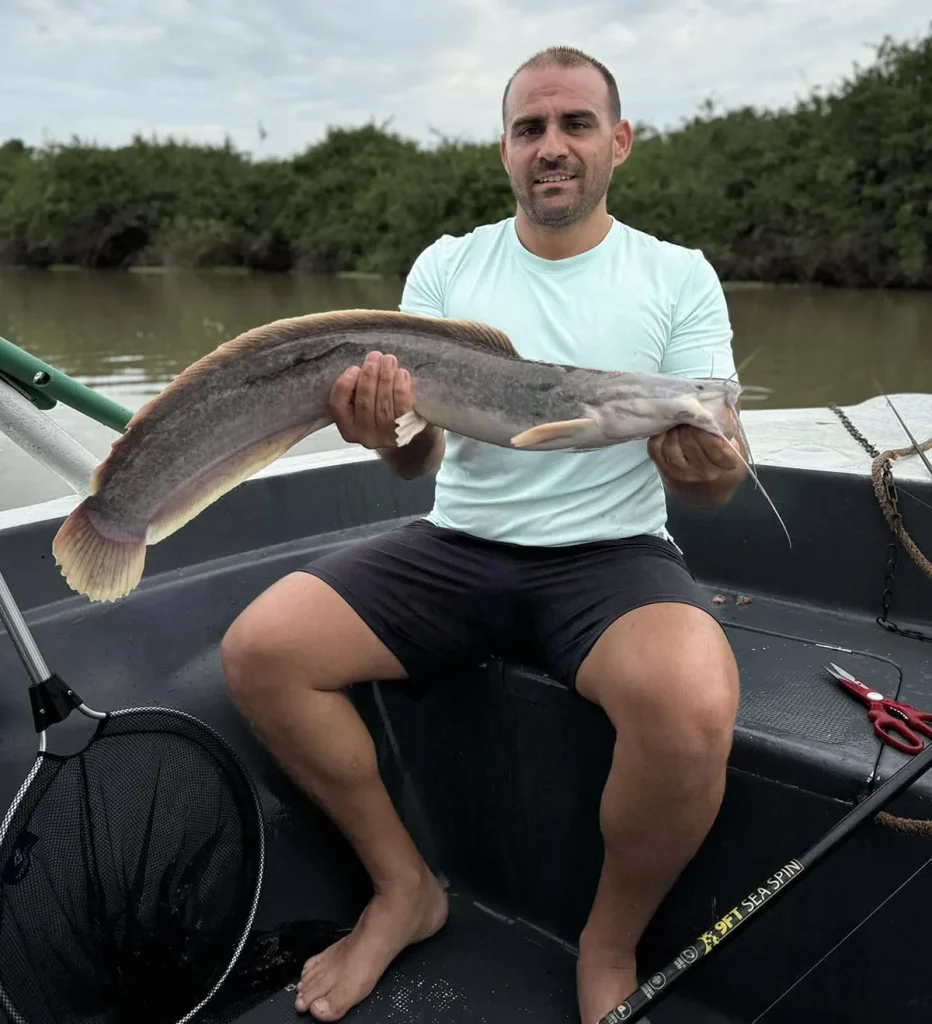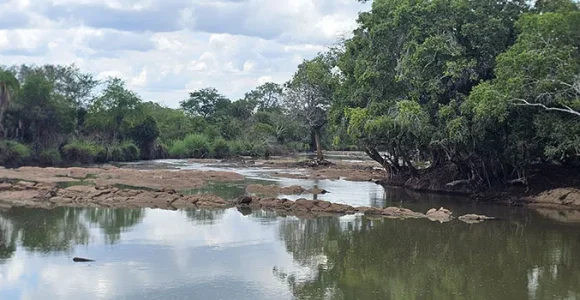Nestled between Dar es Salaam and Morogoro, the Wamimbiki Game Reserve, with an area of 2,466.58 square kilometres, was gazetted through Government Notice (GN) Number 457 of June 25, 2021. Conservation of the area dates back to 1997, when the 24 villages surrounding the area agreed to set aside 2500 km2 of their land and protect it as a Wildlife Management Area (WMA).
Unlike Tanzania’s more famous national parks, Wami Mbiki remains a well-kept secret, offering a truly off-the-beaten-path safari experience. The reserve is easily reached by road in about two to three hours, making it ideal for a weekend escape or a quieter stopover before or after a journey to larger parks such as Mikumi or Nyerere National Park.
The name Wamimbiki refers to two main rivers that cross and feed the area. The Wami River, the only permanent water source within the reserve, is 80 km long, bisecting the reserve from east to west, and the seasonal Mbiki River at the southern part.
How to Get There to Wamimbiki Game Reserve
The reserve can be accessed by road, as it is situated approximately 150 km from Dar es Salaam and 62 km from Morogoro via the Dar es Salaam–Morogoro road, 68 km from Bagamoyo via the Msata road, and 20 km from Turiani via the Mtibwa Sugar estate.
Accessed by train through standard gauge railway from Dar es Salaam to Dodoma Via Ngerengere station, 45km.
By air through Julius Nyerere International airport to Dar es Salaam, with chartered flights to Morogoro, Bagamoyo and/or Mtibwa Sugar airstrips.
Climate
The reserve falls within the warm tropical climate with short rains from October to December and Long rains from March to May. It receives an average annual rainfall of between 700mm and 900mm, and an average temperature of between 26°C and 28 °C.
Geology and Topography
Most of the reserve is flat, with an altitude between 350m and 400m, and a few highest spots reaching 500m above sea level.l The slightly elevated northern and Southern segments form a watershed for Wami, Mbiki and Ngerengere rivers. The reserve has mainly clay, Sand and loam types of soils.
Vegetation
The reserve has four types of vegetation communities:
Miombo Woodland (89.6%), which forms the northeastern limit of the African dryland Forest ecosystem across southern Africa. Here are dominated by Julbenardia globiflora and Brachstegia spiciformis,
Acacia (8.1%) – Combretum woodland extending from the Eastern part to the northern boundary. Dominated by Combretum species, A. nigrescens and A.robusta,
Riverine forests (1.1%): These are found along the Wami River, with tree species such as Albizia petersiana, Terminalia spinosa, and Combretum imbibe, associated with palm Hyphaene and Phoenix, which extend on either side of the river.
Thicket communities (1.2%): This vegetation is primarily found in patches dominated by Grewia dichrostachys and Acalypha, with succulent Euphorbia species also present. Some areas have dense thickets on dry red soils
Key Attractions in Wamimbiki Game Reserve
Diverse Wildlife
Wamimbiki Game Reserve is home to a diverse array of wildlife species, including the Greater Kudu, Elephant, Buffalo, Hippos, Zebra, Impala, Waterbuck, Duiker, Yellow Baboon, Velvet Monkey, Bush Pig, and a significant population of carnivores such as Lions, Leopards, Hyenas, Wild Dogs, and Crocodiles along the Wami River.
Also, the reserve harbours some of the IUCN-listed species of rare and threatened plants such as Dalbergia melanoxylon and Pterocarpus angolensis
The Wami River
The Wami River is a central feature of the reserve, winding through its heart and attracting a diverse array of wildlife. Hippos wallow in the deeper pools, crocodiles sun themselves on sandy banks, and large mammals come to drink, especially in the dry season. The riverine forest along the banks creates shady habitats where birds, monkeys, and smaller animals thrive. The river also provides beautiful, tranquil views at sunrise and sunset.
Rich Birdlife
Birdwatching is one of the most rewarding activities at Wami Mbiki. Over 400 species have been recorded here, making it a haven for bird enthusiasts. African fish eagles call from perches above the river, storks and herons patrol wetlands, and colourful kingfishers flash across the water. During the rainy season, migratory species arrive, creating spectacular scenes of bird activity and breeding displays.
Scenic Landscapes
The reserve features an extraordinary variety of landscapes that shift with the seasons. Open savannahs stretch toward the horizon, dotted with acacia trees and termite mounds. Dense woodlands provide shade and cover for shy wildlife. After the rains, the floodplains turn green and vibrant, offering a dramatic contrast to the dry season’s golden grass. The diverse habitats make every game drive and walk feel different and fresh.
Sunset Views and Night Sounds
As the day winds down, the reserve becomes especially magical. Sunset paints the grasslands in shades of gold and pink, while wildlife gradually retreats into the shadows. Nights bring a chorus of sounds: the distant whoop of hyenas, the hoots of owls, and the steady background hum of insects. Sitting around a fire under a star-filled sky is a simple but unforgettable highlight of any visit.
Mosaic of different vegetation communities:
The reserve functions as an ecotone for the three biome–restricted species assemblages of the Somali-Masai, East African Coast, and Zambezian eco-regions. The resulting biota contains the majority of the arid-adapted, Miombo woodland and coastal species, including large trees ranging from Albizia, Brideria, Brachystegia, Jurbenadia to Acacia.
Historical attractions:
The reserve harbours various sites used for rituals, sacred and Historical purposes. The areas are considered to have special spiritual qualities for communities living adjacent to the reserve. Such regions include big stones, Spring, A footstep on a big stone, Swamps, Trees, Streams, Forest, Burial sites, Caves and Historical attractions like Jiwe la Msikiti that resembles an Islamic religious symbol (Kibra) and a 70km long road which is a part of the central slave and ivory trade route.
Tourism Activities in Wamimbiki Game Reserve
Sport Fishing
Sport fishing at Wami Mbiki Game Reserve presents an exciting opportunity to catch a diverse range of freshwater fish in a pristine and scenic setting. The reserve’s rivers and lakes are home to species such as tigerfish, catfish, and tilapia, making it a popular spot for anglers seeking both challenge and adventure. Whether you’re a seasoned angler or a beginner, sport fishing here provides a thrilling experience amid nature’s beauty. Remember to check local regulations and obtain the necessary permits before your trip to ensure a responsible and enjoyable fishing experience.
Game Drives
Guided game drives in open vehicles offer the best way to explore the diverse habitats and observe wildlife up close. Early morning and late afternoon drives are especially rewarding, when animals are most active and the light is perfect for photography.
Walking Safaris
Experience the bush on foot with a guided walking safari. Led by knowledgeable rangers, these walks allow you to track animals, study plants, and appreciate the smaller details of the ecosystem that are often overlooked during vehicle safaris.
Birdwatching
With its rich mix of woodlands, rivers, and wetlands, Wami Mbiki is one of the most exciting birding destinations in eastern Tanzania. Whether you’re an experienced birder or a casual observer, the sheer diversity and abundance of species will delight you.
Canoeing
Seasonal canoe trips along the Wami River offer a peaceful and scenic way to observe hippos, crocodiles, and water birds as you drift quietly past the riverbanks.
Night Game Drives
For a glimpse into the nocturnal world, night drives reveal creatures rarely seen by day, including genets, civets, bush babies, and owls.

Staying in Wami Mbiki Game Reserve
Within Wami Mbiki Game Reserve, the main and most popular accommodation option is Wami Mbiki Bandas and Campsites. This rustic accommodation offers a selection of self-contained cottages and family bandas, featuring simple and comfortable rooms, as well as designated campsites for visitors who bring their tents. Kanuth Adventure Safari offers a private chef who will prepare your meals and refreshments at the on-site restaurant and bar. Basic facilities are also available for groups and small conferences. Staying here allows you to immerse yourself fully in the reserve’s wildlife and natural beauty, making it the most convenient and frequently used option for overnight visitors who want to experience the heart of Wami Mbiki.

Best Time to Visit Wami Mbiki Game Reserve
Wami Mbiki can be visited year-round. The dry season, from June to October, is ideal for wildlife viewing, as animals congregate at rivers and waterholes. Clear skies and low humidity make this the most comfortable time for safaris. From November to May, rains turn the reserve lush and green, attracting many migratory birds. While some roads become muddy, the vibrant landscapes and rich birdlife reward those who visit in the wet season.
Wami Mbiki Game Reserve is perfect for a weekend escape or a unique safari stopover.
Kanuth Adventure Safaris, one of the best tour companies in Dar es Salaam, is ready to take you there. Contact us today at +255 754 967 544 to book your trip!






